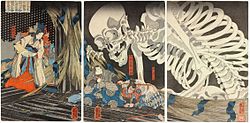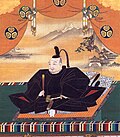Ukiyo-e

Ukiyo-e (浮世絵), "pictures of the floating world", is a genre of Japanese woodblock prints. They were produced between the 17th and the 20th centuries and showed landscapes, tales from history, the theatre, and brothels. It is the main artistic genre of woodblock printing in Japan.
Ukiyo-e were cheap because they could be mass-produced. They were meant for mainly townsmen, who were generally not rich enough to pay an original painting. The original subject of ukiyo-e was city life, in particular activities and scenes from the entertainment district. Beautiful courtesans, big Sumo wrestlers and popular actors would be portrayed while doing interesting activities. Later on landscapes also became popular. To this day, Ukiyo-e is still very popular across the world.
A novelist of the time period, Asai Ryōi, in his Ukiyo monogatari (浮世物語, "Tales of the Floating World", c. 1661), gives an insight into the idea of the floating world:
- "Living only for the moment, turning our full attention to the pleasures of the moon, the snow, the cherry blossoms and the maple leaves; singing songs, drinking wine, diverting ourselves in just floating, floating; ... refusing to be disheartened, like a gourd floating along with the river current: this is what we call the floating world".[1]
Ukiyo-e Media
Maple Viewing at Takao (mid-16th century) by Kanō Hideyori is one of the earliest Japanese paintings to feature the lives of the common people.[2]
- Tokugawa Ieyasu established his government in the early 17th century in Edo (modern Tokyo).Portrait of Tokugawa Ieyasu, Kanō school painting, Kanō Tan'yū, 17th century
The Hikone screen may be the oldest surviving ukiyo-e work, dating to c. 1624–1644.
References
- ↑ Lane, Richard 1978. Images from the Floating World. Old Saybrook, CT: Konecky & Konecky, p11.
- ↑ Kobayashi 1997, p. 66.
Other websites
| Wikimedia Commons has media related to Lua error in Module:Commons_link at line 62: attempt to index field 'wikibase' (a nil value).. |
- A Guide to the Ukiyo-e Sites of the Internet Archived 2007-09-14 at the Wayback Machine
- Kuniyoshi Project
- Gallery with a lot of info
- Overviews of the Printmaking Process detailed description of the stages of printmaking with many illustrations









